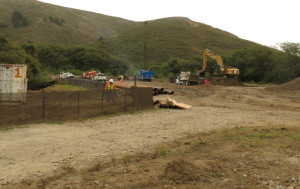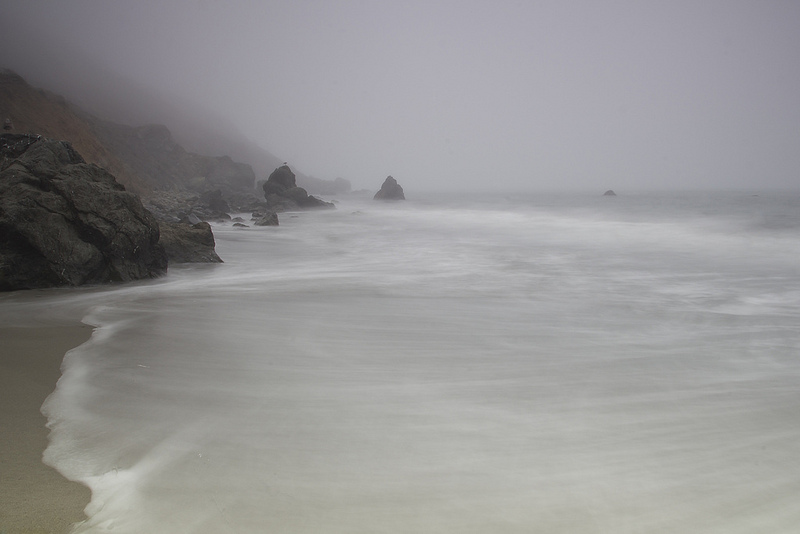Muir Beach has always been a beloved coastal sanctuary for Bay Area residents, but until December it will be notably empty of human form due to the recent closure of the parking lot. Instead, the endangered coho salmon will be the ones kicking back on the coast in what have been dubbed “coho cabanas.”
These driftwood ‘cabanas’, built by the Redwood Creek Restoration Project (RCRP), serve as safe houses for the salmon, which avoid predators by using the structures as stepping stones along their up- and downstream migrations.
“In this geographical area of California [the coho] are endangered, and this is a really important creek for coho,” said Carolyn Shoulders, project manager for the RCRP. “The one thing that we can do for them in our channel is improve their rearing habitat.”

This feature is just a small piece in the broader puzzle of the decade-long restoration effort. In the long run, the RCRP is a large-scale project that aims to strengthen the Redwood Creek ecosystem by restoring the creek channel and opening up the floodplain. These changes will enable the ecosystem to better accommodate runoff from Mount Tamalpais while supporting a flourishing riparian habitat.
The parking lot closure, which began this July, may be the most drastic and visible sign of the restoration project, but smaller changes have been occurring for four years directly under the noses of beach-goers. The demolition and relocation of the parking lot marks the culmination of the project, enabling years of work to finally show their effects.
On a recent tour of the site, Shoulders pointed out the narrow width of the floodplain under a bridge crossing Redwood Creek — about 25 feet on either side. All the runoff from the southern flank of Mt. Tam, which is about 8.9 square miles, culminates at this point.
Such heavy water flow, however, requires a wide and open floodplain, and by ecological standards, 25 feet is far too slim. A wide floodplain allows the creek to adapt to changes in water and sediment flow, enables fish to retreat to calmer waters during heavy currents, and fosters diverse wildlife. Throughout the 20th century, various human alterations of the landscape narrowed the floodplain and disrupted its connection to the creek.

“When the parking lot was built, it became, in essence, the final straw, because it’s a dam,” Shoulders explained.
During high flows, water has been unable to disperse into the floodplain and flow to the ocean, which has led to sediment build up, causing serious flooding upstream. Flooding roads made people aware of the deeper ecological problems.
“It would take a pretty routine rain event,” Shoulders said. “The creek had just lost its capacity.”
Hoping to heal the wounded ecosystem, the National Parks Service began planning the restoration process in 2002. In 2008, after six years of scientific analyses and bureaucratic processes, they got the permits. In the summer of 2009, the NPS and the Golden Gate Parks Conservancy began the restoration process.
At the beginning of the site tour, Shoulders and I stepped off the trail near Pelican Inn to take a look at the creek channel. The first thing I noticed was what looked like brown cloths perched upon stacks of driftwood, littering the shallow sides of the creek. I was confused why a restoration project, hoping to restore the ‘naturalness’ of a creek, would leave such a visible mark,.
“It’s funny because we get more questions about them than almost anything else out here, because they look like they don’t fit,” said Shoulders.
As it turned out, these were the ‘coho cabanas’, which have been indispensable in aiding a gradual resurgence in the coho population. The entire creek channel that houses the cabanas was carefully designed and dug out, so as to return the creek to its natural position.
“That was a very precise effort there,” Shoulders said. “[A hydrologist] analyzed how deep and how wide the channel should be, what the elevation of the floodplain should be, as well as what the gradient should be.”
During the summers of 2009-2011, they implemented the design, establishing a precise relationship between the depth of the creek and the height of the adjacent floodplain.

And the results have been remarkable. The changes have resulted in a burgeoning riparian habitat, with developing alder and spruce trees. As the habitat develops and the woodlands become denser, bird population and diversity is expected to grow along with it.
Another important ecological feature of the new and improved Redwood Creek is a series of back-channel areas, which are like branches off of the main trunk of the creek. These back-channel areas serve the dual purpose of enhancing habitat and creating a safe rearing environment for the endangered coho salmon.
“We have an off-channel pond down here that other fish biologists are very excited about. In the literature, they are finding that during winter flows coho escape to these little off-channel areas, so we created a number in our design.”
When Shoulders took me to one of these back-channel areas she said that it was “the first time she’d seen it so filled in.” Three years is a short amount of time on the ecological clock, and to see such rapid change is exciting and encouraging, she said.
A huge chunk of the restoration has already been completed, but one drastic problem is now finally being addressed: the parking lot. The parking lot, which ran north-south, plugged the channel and covered the floodplain. It’s now being moved 90- degrees so that it will run east-west. The change will give the creek channel 450 feet of wiggle-room.
Once Muir Beach reopens this winter, a long pedestrian bridge will traverse the length of the floodplain, placing visitors smack-dab in the middle of a flourishing ecosystem.
“We are completely accommodating visitor access,” Shoulders said. “But in general we feel that when you come to the beach, you’ll have a little more of an experience of a natural area.”
One of the most exciting features of the design is the way in which it accounts for change over time. In fact, the entire design is based on letting the creek grow and adapt as the water ebbs and flows, something it has not been able to do for many years. The result has been a beautiful marriage of the human needs and the natural needs, which will now mutually enhance each other for years to come.
“It is, in essence, green engineering,” said Carolyn Shoulders. “You still accommodate people, still accommodate the human use, and you’ve accommodated fully the natural processes.”
Will Fraker is a Bay Nature editorial intern.





